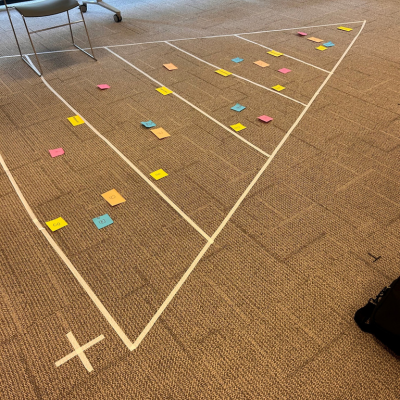Our 'Lencioni on the floor' approach
We all know Lencioni's pyramid, right? At Highberg, we go further than just the well-known model. The road to a high-performing team seems simple on paper, but in truth is quite challenging. First, define a 'high performing team': a team that communicates and collaborates extremely effectively at the highest level to achieve common goals.

But where do teams get stuck?
Trust, the backbone of any team, grows slowly but crumbles quickly. Even close-knit teams can find themselves in an unsafe undercurrent due to an incident, often leading to superficial harmony, suppressed voices, and subgroup formation.
Take, for example, a close-knit marketing team that always communicated openly. But as a crucial project approached, one team member began to take on more work without showing it to others. She felt pressured to perform and was hesitant to ask for help because she was afraid it would call into question her competence. The colleagues did notice her increased stress but did not express it directly. This created false harmony and underlying tension. People spoke less, tasks were not distributed properly. The team became divided, and the once strong bond began to fade due to unspoken tensions.
Avoiding conflict seems sensible, but constructive conflict is valuable for teams. They bring different perspectives to life and lead to better decisions. But in practice, conflict remains 'a dirty word', and so valuable information is lost. Employees who speak up less often start to feel less ownership, become less creative and motivated. Again, an unhelpful outcome.
Another example: at an innovative media company, the development team had regular meetings to discuss new ideas. During one of these meetings, one of the team members had an idea for a radical change in product design. He kept his idea to himself, because he knew that some team members were against this kind of change. Over time, multiple team members began to speak up less and this resulted in a decrease in ownership, but also to stagnation of progress and innovation within the team. This example shows how avoiding constructive conflict can lead to the loss of valuable insights and contributions, as well as motivation and growth.
If you do what you did, you get what you’ve got
Teams that seem successful can stagnate if their results don't align with business goals. We often hear that a team is already achieving results, the top layer of the pyramid, and that interventions are no longer necessary. If the result is sufficient, it is. But if the business goals are different and more is asked of the team than it currently delivers, it is very helpful to walk up the pyramid and explore where this team can still learn something.
Take, for example, a team that excelled at meeting KPIs for client satisfaction and project delivery at a graphic design agency. They seemed to be at the top of Lencioni's pyramid, but when the company wanted to reposition itself in the market and focus on innovation and creativity, they stuck to their existing approach. While their performance was good, the team lacked new ideas and creative approaches that fit the new business goals. By sticking to what had brought them previous success, they ignored the need for change and innovation.
This example highlights that when meeting objectives, teams need to evaluate whether these objectives are still in line with the changing needs of the business to ensure growth and adaptability.

Our approach: in-depth team analysis according to Lencioni: A Practical Dive
Do you really want to understand the dynamics of your team? Then try the 'Lencioni on the Floor' approach! Each team member, including the leader, dives individually into the five rows of the pyramid and scores the team from one to 10:
- Trust: How deeply do team members trust each other? Write it down on a note and stick it on the pyramid
- Confrontation of Conflicts: How does the team tackle conflicts? Is there open discussion where all sides can speak up, and are disagreements effectively resolved?
- Commitment to Decision Making: Are team members involved in decision-making? Do they make decisions with involvement?
- Responsibility for Agreements: To what extent do team members hold each other accountable for agreements made?
- Result-Oriented Attention: Does the team work together effectively to achieve common goals? Are individual goals secondary to the team result?
The magic happens when all the notes are placed next to each other on the pyramid. It creates a visual representation of the team’s strengths and weaknesses, the perfect kick-off for an in-depth conversation.
In the debriefing, the team can discuss the following:
- What deserves attention? Are there any patterns in the scores? Which areas are crying out for improvement
- What to do? How can we address and strengthen weaknesses? What are concrete actions to improve team dynamics
- How to make a +1 step? What can team members do individually and as a group to make positive change
This approach fosters open communication and collaboration. The result? Not only a better understanding of team dynamics, but also concrete steps towards improvement. 'Lencioni on the Floor' is not just a snapshot, but first step in continuous growth and development within your team.
Related insights

